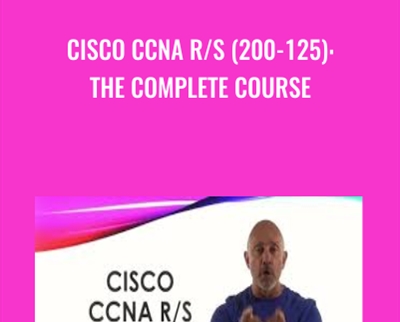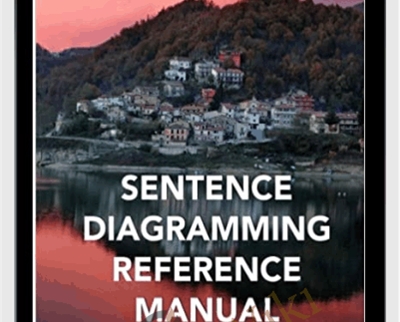Buy Cisco CCNA R/S (200-125): The Complete Course – Lazaro Diaz Course at GBesy. We actively participate in Groupbuys and are committed to sharing knowledge with a wider audience. Rest assured, the quality of our courses matches that of the original sale page. If you prefer, you can also buy directly from the sale page at the full price (the SALEPAGE link is directly provided in the post).
Salepage link: At HERE. Archive:
$35 $10 – Cisco CCNA R/S (200-125): The Complete Course – Lazaro Diaz
This course is for Cisco’s newest certification, the CCNA R/S 200-125, that became effective on August 21st, 2016.
Cisco certifications do have an expiration date and they need to be renewed every couple of years.
The course was produced in a very effective manner where you, the student, would feel as if you are in a classroom setting and the instructor is speaking directly to YOU.
Following Laz’s instructions and using his recommendations for other resources like books, etc., has proven to be the key to lead his students to achieve success in passing the certification exam.
Laz’s style of teaching, (and there is a method to his madness), is very laid back and somewhat unorthodox, as you will see for yourself.
However, this is to make the topics covered more digestible and easier for anyone to understand. Even if you are totally new to Networking.
So, whether you are a novice, need to pass the CCNA or just need a refresher for your current job, this course has everything you need.
Don’t doubt the Instructor with the proven record, but rather embrace his knowledge and his experience when it comes to this; after all…his reputation depends on your success!
You will acquire the knowledge in this course to make it transferable to real world use, as a Cisco and/or IT Professional.
DISCLAIMER: Please note that the simulators/emulators used in this course are not part of the course. It is the students responsibility to have these to practice with. The Cisco Packet Tracer & VIRAL (Virtual Internet Routing Lab) are Cisco proprietary software and can only be obtained through Cisco. But students have more options than those. They can create their own lab with real equipment, get BOSON or GNS3. It is up to each student to obtain the simulator/emulator of their choice to study along with this course.
BOOKS USED IN THE COURSE: CCNA R/S by Cisco Press, Sybex CCNA Study Guide by Todd Lammle & The Only IP Book You Will Ever Need!, by Lazaro J. Diaz – These are ALL available on AMAZON
This course will give you an in-depth understanding of networking, using routers and switches and their various configurations and connections. You will learn how to configure; default, static and dynamic routing. You will comprehend how to manipulate each of the routing protocols attributes to meet the requirements of the network.
This course will also prepare you in Layer 2 technology and its various configurations, such as; VLAN’s, VTP, STP, PortFast, EtherChannel, Port-Security, Inter-VLAN communication & Trunking; plus the newest requirements needed for CISCO’s NEW CCNA (200-125) certification exam as well.
You will also acquire the knowledge needed to secure the routers through the use of Access-list, configuring the different types of NAT & will be able to manage the router’s components.
As students, you will also be able to thoroughly grasp the concepts of both Internet Protocols; IPv4 & IPv6. These are KEY to any Network!
Please keep in mind that Laz has his own book called “The Only IP Book You Will Ever Need!” that will further help those that need a more in-depth understanding of IPv4 & IPv6.
Also covered in this course is Wide Area Network Protocols like HDLC, PPP, Frame Relay, HSRP, BGP, MPLS, NHRP, MGRE among other things.
You will also learn how to create redundancy in networks through the use of Redundancy Protocols such as HSRP which is just as important. Also, within the WAN, you, the student, will also learn how to create VPN’s and GRE Tunnels among other things that are crucial in passing the new CCNA.
Great achievements and success is at your grasp!
All you need to do is let this course guide you through it.
The possibilities are going to be endless once you take this CCNA certification course.
Pre-requisites
- CCNA R/S by Cisco Press, Sybex CCNA Study Guide by Todd Lammle
Target Audience
- This course was prepared for those that need to pass the CCNA R/S 200-125 certification exam
- Students that are currently in College or University for Networking of Computer Science degrees
- Anyone that wants to advance their career into Networking
Curriculum
Section 1 : Introduction to the CCNA (200-125) The Complete Course
- Lecture 1 : Introduction to the CCNA Course
Section 2 : Introduction to TCP/IP Networking
- Lecture 1 : Introduction to TCP/IP Networking
- Lecture 2 : Perspectives on Networking
- Lecture 3 : The Application Layer of the TCP/IP Model
- Lecture 4 : The Transport Layer of the TCP/IP Model
- Lecture 5 : The Network Layer of the TCP/IP Model
- Lecture 6 : The Link and Physical Layer of the TCP/IP Model
- Lecture 7 : Summary of Section
Section 3 : The Breakdown to the OSI Model
- Lecture 1 : The OSI Model
- Lecture 2 : Comparing the OSI Model with the TCP/IP Model
- Lecture 3 : OSI Layers and their functions
- Lecture 4 : OSI Layering Concepts and benefits
- Lecture 5 : Summary of Section
Section 4 : A Look at the Cisco Models
- Lecture 1 :
- Cisco Three Layer Model
- Lecture 2 : Cisco Collapsed Architecture
- Lecture 3 : Summary of Section
Section 5 : An Introduction to Ethernet LANs
- Lecture 1 :
- An Overview of LANs
- Lecture 2 :
- Common Small Office Home Office LAN
- Lecture 3 :
- Common Enterprise LAN
- Lecture 4 :
- Ethernet Cabling Standards
- Lecture 5 :
- Summary of Section
Section 6 : Nodes used on Ethernet LANs
- Lecture 1 :Devices used on Ethernet Networks
- Lecture 2 : Summary of Section
Section 7 : Introduction to IPv4 Addressing
- Lecture 1 : Introduction to IPv4 Addressing
- Lecture 2 : Format and Classes of an IPv4 Address
- Lecture 3 : Private IP Addressing
- Lecture 4 : Summary of Section
Section 8 : Class-Full Subnetting in IPv4
- Lecture 1 : Class-Full Subnetting in IPv4
- Lecture 2 : Subnetting a Class “C” Address
- Lecture 3 : Subnetting a Class “B” Address
- Lecture 4 : Subnetting a Class “A” Address
- Lecture 5 : Summary of Section
Section 9 : VLSM
- Lecture 1 : Variable Length Subnet Masking
- Lecture 2 : VLSM Breakdown
- Lecture 3 : Creating a VLSM Network
- Lecture 4 : Summary of Section
Section 10 : Route Summarization
- Lecture 1 : Route Summarization
- Lecture 2 : Summarization Breakdown
- Lecture 3 : Assigning the summary Address
- Lecture 4 : Summary of Section
Section 11 : Configuration within the CLI
- Lecture 1 : Introduction to Cisco’s CLI
- Lecture 2 : Navigation through the CLI
- Lecture 3 : Cisco Router Components
- Lecture 4 : Router Boot Sequence
- Lecture 5 : Password Recovery Procedure
- Lecture 6 : Router Administrative Commands
- Lecture 7 : Router Interface Commands
- Lecture 8 : Summary of Section
Section 12 : All About Routing
- Lecture 1 : Routing Packets in your network
- Lecture 2 : Default Routing
- Lecture 3 : Static Routing
- Lecture 4 : Dynamic Routing
- Lecture 5 : Configuring RIPv2
- Lecture 6 : Passive-Interface Interface
- Lecture 7 : Configuring the Passive-Interface Command
- Lecture 8 : RIPv2 Default Routes
- Lecture 9 : Configuring RIPv2 Default Routes
- Lecture 10 : Summary of Section
Section 13 : The EIGRP Routing Protocol
- Lecture 1 : EIGPR Routing Protocol
- Lecture 2 : Basic Configuration of EIGRP
- Lecture 3 : The EIGRP Topology Table
- Lecture 4 : Successor and feasible Successor Routes
- Lecture 5 : The EIGRP Neighbor Table
- Lecture 6 : Using Wildcards to Configure EIGRP
- Lecture 7 : Tweaking the Bandwidth in EIGRP
- Lecture 8 : Load balancing with EIGRP
- Lecture 9 : Summary of Section
Section 14 : All About OSPF
- Lecture 1 : All About OSPF
- Lecture 2 : OSPF Basic Lab
- Lecture 3 :
- Designated and Backup Router lab
- Lecture 4 : Multi-Area OSPF Lab
- Lecture 5 : OSPF Authentication Lab
- Lecture 6 : Summary of Section
Section 15 : All about Switching
- Lecture 1 : LAN Switching
- Lecture 2 : Configuring Common Commands on a Switch
- Lecture 3 : The Spanning-Tree Protocol
- Lecture 4 : Spanning-Tree Protocol Election Process
- Lecture 5 : Manipulation of STP
- Lecture 6 : Summary of Section
Section 16 : All about VLANs
- Lecture 1 : Using VLANs on our Network
- Lecture 2 : VLAN Configuration
- Lecture 3 : Using the Virtual Trunking Protocol
- Lecture 4 : Trunking Ports on L2 Switches
- Lecture 5 : Securing ports on a Switch
- Lecture 6 : Summary of Section
Section 17 : Welcome to Inter-VLAN Routing and EtherChannel
- Lecture 1 : Inter-VLAN Routing
- Lecture 2 : Ether-Channel
- Lecture 3 : EtherChannel Configuration
- Lecture 4 : Summary of Section
Section 18 : Welcome to IPv6
- Lecture 1 : The In’s and outs of IPv6
- Lecture 2 : Assigning IPv6 Addresses to an interface
- Lecture 3 : Static Routing in IPv6
- Lecture 4 : RIPng Configuration
- Lecture 5 : EIGRPv6 Configuration
- Lecture 6 : OSPFv3 Configuration
- Lecture 7 : Dual Stack
- Lecture 8 : Subnetting in IPv6
- Lecture 9 : Summary of Section
Section 19 : Welcome to Access-List
- Lecture 1 : Unraveling Access List
- Lecture 2 : Standard ACL Configuration
- Lecture 3 : Standard ACLs for Telnet
- Lecture 4 : Extended ACL Configuration
- Lecture 5 : Named ACL Configuration
- Lecture 6 : Using the REMARK Command in ACL
- Lecture 7 : Summary of Section
Section 20 : Welcome to NAT
- Lecture 1 : Network Access Translation
- Lecture 2 : Configuring NAT Overload
- Lecture 3 : Summary of Section
Section 21 : Welcome to Wide Area Network
- Lecture 1 : Wide Area Networks
- Lecture 2 : Configuring PPP
- Lecture 3 : Configuring Frame Relay
- Lecture 4 : Summary of Section
- Lecture 5 : Configuring GRE Tunnel
- Lecture 6 : Radius Lab
- Lecture 7 : TACACS+ Lab
- Lecture 8 : IPSLA Lab
Section 22 : Welcome to MPLS
- Lecture 1 : What is MPLS?
- Lecture 2 : Basic MPLS Lab
- Lecture 3 : MPLS VPN Layer 2
- Lecture 4 : MPLS VPN Layer 3
- Lecture 5 : Summary of Section
Section 23 : Welcome to BGP
- Lecture 1 : Welcome to BGP
- Lecture 2 : Comparison BGP Lab iBGP VS. eBGP Lab
- Lecture 3 : Minimal eBGP Lab explained
- Lecture 4 : Summary of Section
Section 24 : Introduction to HSRP
- Lecture 1 : Welcome to HSRP
- Lecture 2 : HSRP Lab
- Lecture 3 : Summary of Section
Section 25 : Welcome to DMVPN
- Lecture 1 : Intro to DMVPN
- Lecture 2 : DMVPN Lab
- Lecture 3 : Summary of Section
- Lecture 4 : vpn
Section 26 : IP Services
- Lecture 1 : Introduction to IP Services
- Lecture 2 : SNMP Lab
- Lecture 3 : Summary of Section
Section 27 : Managing a Cisco Intetnetwork
- Lecture 1 : Configuring DHCP
- Lecture 2 : DHCP Relay Agent
- Lecture 3 : Verifying DHCP on a Cisco IOS
- Lecture 4 : Network Time Protocol (NTP)
- Lecture 5 : Resolving Hostnames
- Lecture 6 : Summary of Section
Section 28 : Introduction to Evolution of Intelligent Networks
- Lecture 1 : Introduction to the Evolution of Intelligent Networks
- Lecture 2 : Application Programming Interfaces (API)
- Lecture 3 : Cisco APIC-EM
- Lecture 4 : Summary of Section
Section 29 : Licensing
- Lecture 1 : Licensing a Cisco Router
- Lecture 2 : Licensing Lab
- Lecture 3 : Summary of Section
Section 30 : Summary of Course
- Lecture 1 : Summary of Course
Section 31 : Bonus Lab
- Lecture 1 : Extreme Challenge Lab From Scratch!
Section 32 : Quality of Service (QoS)
- Lecture 1 : QoS Introduction
- Lecture 2 : QoS Lab
- Lecture 3 : QoS Explanation
$35 $10 – Cisco CCNA R/S (200-125): The Complete Course – Lazaro Diaz
Buy the Cisco CCNA R/S (200-125): The Complete Course – Lazaro Diaz course at the best price at GBesy.. After your purchase, you will get access to the downloads page. You can download all the files associated in your order at here and we will also send a download notification email via your mail.
Unlock your full potential with Cisco CCNA R/S (200-125): The Complete Course – Lazaro Diaz courses. our courses are designed to help you excel.
Why wait? Take the first step towards greatness by purchasing Cisco CCNA R/S (200-125): The Complete Course – Lazaro Diaz courses today. We offer a seamless and secure purchasing experience, ensuring your peace of mind. With our trusted payment gateways, Stripe and PayPal, you can confidently complete your transaction knowing that your financial information is protected.
Stripe, known for its robust security measures, provides a safe and reliable payment process. With its encrypted technology, your sensitive data remains confidential throughout the transaction. Rest assured that your purchase is protected.
PayPal, a globally recognized payment platform, offers an additional layer of security. With its buyer protection program, you can feel confident in your purchase. PayPal ensures that your financial details are safeguarded, allowing you to focus on your learning journey.
Is it secure? to Use of?
- Your identity is completely confidential. We do not share your information with anyone. So it is absolutely safe to buy the Cisco CCNA R/S (200-125): The Complete Course – Lazaro Diaz course.
- 100% Safe Checkout Privateness coverage
- Communication and encryption of sensitive knowledge
- All card numbers are encrypted using AES at relaxation-256 and transmitting card numbers runs in a separate internet hosting atmosphere, and doesn’t share or save any data.
How can this course be delivered?
- After your successful payment this “Cisco CCNA R/S (200-125): The Complete Course – Lazaro Diaz course”, Most of the products will come to you immediately. But for some products were posted for offer. Please wait for our response, it might take a few hours due to the time zone difference.
- If this happens, please wait. The technical department will process the link shortly after. You will receive notifications directly by e-mail. We appreciate your wait.
What Shipping Methods Are Available?
- You will receive a download link in the invoice or YOUR ACCOUNT.
- The course link always exists. use your account to login and download the Cisco CCNA R/S (200-125): The Complete Course – Lazaro Diaz course whenever you need.
- You only need to visit a single link, and you can get all the Cisco CCNA R/S (200-125): The Complete Course – Lazaro Diaz course content at once.
- You can do your learning online. You can be downloaded for better results and can study anywhere on any device. Make sure your system does not sleep during the download.
How Do I Track Order?
- We always notice the status of your order immediately after your payment. After 7 days if there is no download link, the system will automatically complete your money.
- We love to hear from you. Please don’t hesitate to email us with any comments, questions and suggestions.
![GBesy [GB] GBesy [GB]](https://www.gbesy.com/wp-content/uploads/2023/05/gbesy-Logo-full-100.png)



 Purchase this course you will earn
Purchase this course you will earn 




![[ETA] Energetic Throat [Chakra] Activation - Rudy Hunter](https://www.gbesy.com/wp-content/uploads/2023/05/Rudy-Hunter-5BETA5D-Energetic-Throat-5BChakra5D-Activation.jpg)
Reviews
There are no reviews yet.